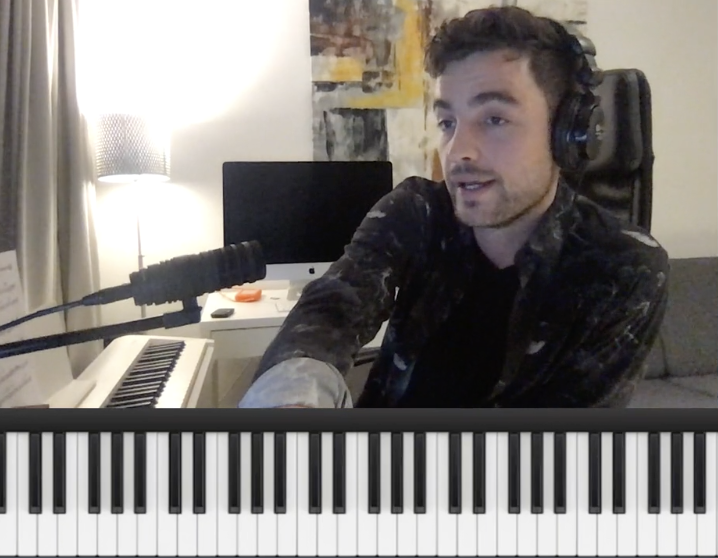
Hayden Hill
Hayden founded PianoGroove in 2015 with the goal of making the world a more musical place. He shares his love for jazz piano through his online courses and manages the community area of PianoGroove.
Live Seminar Resources
Live Seminar Resources
PDF Downloads
- My One & Only Love - Chord Chart
Join PianoGroove Pro to access all downloads and learning resources.
Download theory supplements, midi files, chord changes and full note-for-note transcriptions of every lesson.
- Blue Moon - Chord Chart
Join PianoGroove Pro to access all downloads and learning resources.
Download theory supplements, midi files, chord changes and full note-for-note transcriptions of every lesson.
Related Lessons
Seminar Description
Seminar Description
My One and Only Love – Jazz Piano Breakdown
Welcome to this in-depth exploration of the jazz standard "My One and Only Love" for solo piano. In this lesson, we break down the harmonic structure, explore different voicings, and discuss key techniques to interpret lead sheets effectively.
This session is designed to simulate the process of learning or revisiting a jazz tune, from analyzing chord progressions to crafting a flowing and expressive arrangement. By the end of this lesson, you will have a structured approach to playing "My One and Only Love" with smooth chord transitions and rich harmonic textures.
Understanding the Lead Sheet
The first step in approaching a new jazz tune is analyzing the chord progressions and understanding the harmonic framework.
- This tune is in the key of C major and opens with a 1-6-2-5 progression (Cmaj7 to A-7 to D-7 to G7).
- A notable feature is the passing diminished chord (G#dim7), which functions as a chromatic passing harmony leading into A-7.
- The bridge introduces a minor 2-5-1 (F#-7b5 to B7 to E-7), a crucial sound in jazz.
By identifying these recurring harmonic patterns, we can visualize chord relationships and make informed voicing choices.
Voicing the Chords – From Basic to Sophisticated
We start with basic 7th chords in root position to clearly see the chord structure. Then, we introduce spread voicings, upper structures, and color tones to enhance the harmonic richness.
Simple Voicings:
- Root position 7th chords in the left hand for a solid harmonic foundation.
- Melody-focused approach where the right hand plays the melody with minimal chordal interference.
Advanced Voicings:
- Rootless voicings to create a more contemporary jazz feel.
- Upper structure triads for dominant chords, such as using an F triad over A7 to highlight sharp 5 and sharp 9 extensions.
- Tenth intervals in the left hand for a deeper bass presence.
By starting with basic voicings and gradually adding complexity, we develop flexibility in arranging the tune.
The 3-Note Spread Voicing Approach
A key takeaway from this lesson is the 3-note spread voicing technique, which distributes the chord between both hands to maintain balance and clarity.
For example, in the 1-6-2-5 progression:
- Cmaj7 (C in left, E-G-B in right)
- A-7 (A in left, C-E-G in right)
- D-7 (D in left, F-A-C in right)
- G13 (G in left, F-B-E in right)
This technique helps achieve a full sound without overloading the texture.
The Role of Diminished Chords
A striking harmonic element in "My One and Only Love" is the use of G# diminished 7 (G#dim7). This chord acts as a passing diminished chord, often functioning as a substitute for dominant chords.
Alternative Views:
- G#dim7 = Bbdim7 = Dbdim7 = Edim7
- Can be seen as B♭7(b9) without a root.
- Also functions as E7(b9), the dominant of A minor.
By experimenting with different interpretations of diminished chords, we expand our harmonic palette and develop voice-leading fluency.
The Minor Line Cliché
Another essential concept in this tune is the minor line cliché, which appears in the B section:
- E-7 → E-7(maj7) → E-7(b7) → E-6
- The bass line moves chromatically (E → E♭ → D → C#).
This is a classic descending movement found in many jazz ballads, adding emotional depth and harmonic interest.
5 Practice Tips
-
Visualize the 1-6-2-5 Progression – This is a fundamental progression in jazz. Practice it in all 12 keys to develop muscle memory and harmonic awareness.
-
Experiment with Upper Structures – Try triadic structures over dominant chords. For example, play an F major triad over A7 to highlight A7(#5 #9).
-
Apply 3-Note Spread Voicings – Instead of playing full block chords, distribute the chord tones between both hands to create a more open and balanced sound.
-
Analyze and Mark Passing Diminished Chords – Whenever you see a diminished chord, explore how it connects harmonically. Try substituting B♭7 for G#dim7 to hear the relationship.
- Listen to Multiple Interpretations – Study recordings by Eddie Higgins, John Coltrane, and Keith Jarrett to hear different reharmonization ideas and phrasing techniques.
Final Thoughts
By integrating spread voicings, upper structures, and passing diminished chords, we transform "My One and Only Love" into a rich and expressive solo piano arrangement.
This lesson encourages active listening, harmonic exploration, and creative interpretation, all essential skills for playing jazz standards with confidence.
Ready to take your playing further? Experiment with these techniques in other jazz ballads and watch your harmonic vocabulary expand!






